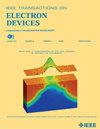Cu–Cu Bonded Microbump Interconnects With a 10-μm Pitch for 3-D-Stacked Chiplets
IF 2.9
2区 工程技术
Q2 ENGINEERING, ELECTRICAL & ELECTRONIC
引用次数: 0
Abstract
This article reports the fabrication and test results of fine-pitch microbump interconnects for stacked chiplets fabricated using a new Cu–Cu bonding method that is developed from Cu–Sn transient-liquid-phase (TLP) bonding. A redox treatment method is devised to change conventional Cu–Sn bumps to porous Cu–Sn bumps that can initiate TLP bonding by forming porous Cu–Sn intermetallic compounds (IMCs). The porous Cu–Sn bonding is changed to dense Cu–Cu bonding by removing the Sn composition using redox reactions and compressing the porous bumps using bonding pressures. The method inherits the merits of low resistivity and high reliability from Cu bonding and low temperature, low pressure, and free of chemical-mechanical planarization (CMP) from TLP bonding. The formation mechanism and the bonding model of the porous bumps are proposed, and the process details are given. The bonding of间距为 10μm 的铜-铜键合微凸块互连器件用于三维堆叠芯片
本文报告了使用一种新的铜-铜键合方法为堆叠芯片制造细间距微凸块互连器件的制造和测试结果,这种方法是从铜-锰瞬态液相(TLP)键合发展而来的。我们设计了一种氧化还原处理方法,将传统的铜-锡凸块转变为多孔铜-锡凸块,通过形成多孔铜-锡金属间化合物 (IMC) 来启动 TLP 键合。通过使用氧化还原反应去除锡成分并使用键合压力压缩多孔凸块,可将多孔铜锡键合转变为致密铜铜键合。该方法继承了铜键合的低电阻率和高可靠性,以及 TLP 键合的低温、低压和无化学机械平面化(CMP)等优点。提出了多孔凸点的形成机理和键合模型,并给出了工艺细节。在芯片互连中演示了间距为 10~\mu $ m 的 1000/times 800$ 微凸块阵列的键合。结果表明,键合的微凸块具有高产量、低电阻和高可靠性。
本文章由计算机程序翻译,如有差异,请以英文原文为准。
求助全文
约1分钟内获得全文
求助全文
来源期刊

IEEE Transactions on Electron Devices
工程技术-工程:电子与电气
CiteScore
5.80
自引率
16.10%
发文量
937
审稿时长
3.8 months
期刊介绍:
IEEE Transactions on Electron Devices publishes original and significant contributions relating to the theory, modeling, design, performance and reliability of electron and ion integrated circuit devices and interconnects, involving insulators, metals, organic materials, micro-plasmas, semiconductors, quantum-effect structures, vacuum devices, and emerging materials with applications in bioelectronics, biomedical electronics, computation, communications, displays, microelectromechanics, imaging, micro-actuators, nanoelectronics, optoelectronics, photovoltaics, power ICs and micro-sensors. Tutorial and review papers on these subjects are also published and occasional special issues appear to present a collection of papers which treat particular areas in more depth and breadth.
 求助内容:
求助内容: 应助结果提醒方式:
应助结果提醒方式:


